How, when and what to feed garlic after winter - advice from experienced gardeners for getting a rich harvest
The healing properties of garlic have been used for centuries in everyday life and medicine. There is no better vegetable than one grown on your own in your own garden. In order for large, healthy heads to form, the plant needs support as it grows. In spring, when nature wakes up, this is most relevant.
What and how to feed garlic after winter in order to maintain its medicinal benefits and not cause harm to health? Read more about this in the article.
Time to fertilize garlic in spring
In the spring, at the beginning of the growing season, garlic needs stimulation to get stronger and resist diseases and pests.
As soon as the snow melts and the ground warms up and does not have time to completely dry out, it is recommended to carry out the first fertilizing of winter varieties.
Why fertilize
The combination of organic matter with mineral fertilizers increases productivity and strengthens garlic’s immunity to various diseases, protects it from pests. However, you cannot overdo it: overfeeding garlic is strictly contraindicated.
Excess mineral fertilizers accumulate in the pulp of garlic heads in a form that is toxic to humans. Excessive organic matter in the soil causes rotting of the planting material.
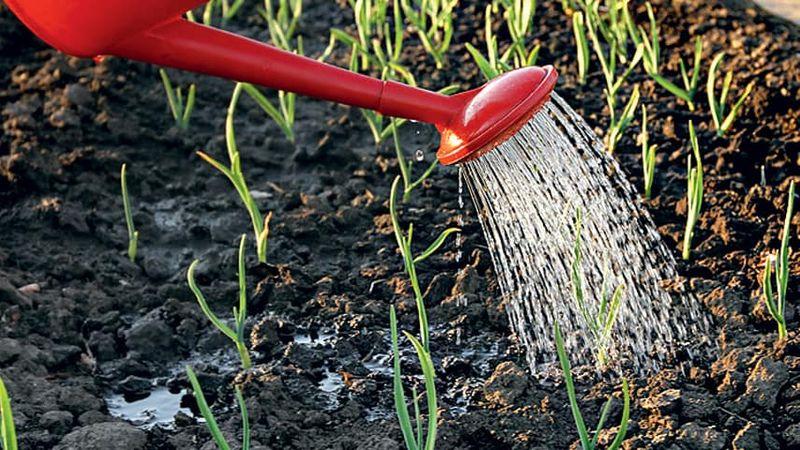
Features of fertilizing winter and spring garlic
The method of adding nutrients is the same for all types of plants. The difference is when to feed winter garlic and when to feed spring garlic.
Winter varieties form a root system in the fall, and in the spring they immediately begin to grow green mass.
Spring crops are planted in the spring, after the soil in the upper 15 cm layer has warmed up to 5-10 degrees. At this temperature, teeth begin to grow more actively, and the root system develops faster.
During the growing season, the need for nutrients changes depending on which parts of the plant are developing. Potassium and calcium predominate in the leaves, nitrogen and phosphorus - in the inflorescences, and in the roots we will find a large percentage of phosphorus and magnesium.
The need also varies depending on the growing season. The standard rule is that young plants require mainly nitrogen to ensure green growth. Potassium and calcium intake gradually increases until the vegetative growth phase. Phosphorus intake is generally uniform throughout the growing season, with the exception of its slight increase during flowering and seed formation.
How to feed yellowing garlic
Leaves turn yellow in different ways:
- the leaf plate between the veins has turned yellow or white, but the color of the veins themselves does not change: there is not enough iron, most often occurs on acidic soils;
- the lower leaves drooped, became deformed, the color of the leaf blade between the veins turned yellow along the edge, the color of the veins did not change, spots of tissue death appeared: lack of magnesium;
- lethargy of leaves, especially the upper ones, delay and stopping of the growth of new shoots, white spots on the tip or along the entire leaf blade: lack of copper, often happens on soils with excess peat;
- the appearance of individual yellow spots on the leaves, primarily the lower ones, followed by tissue death in these areas, new leaves with yellow speckles: zinc deficiency, most often found on swampy or sandy acidic soils;
- the color of the leaves changes to light green, the edges curl, the veins darken, break when bent, the upper shoots are affected, even dying: boron deficiency, happens on swampy, carbonate and acidic soils;
- a large number of brown spots on the lower leaves, but the veins remain green, the surface of the leaf is swollen, the edges are curled, over time, mottling appears on young leaves: there is not enough molybdenum;
- the upper leaves on the sides between the veins first acquired a light green and then a yellow color, less pronounced than with iron chlorosis, the veins remained green, as the leaves aged, the yellowness blurred: lack of manganese;
- thin and sluggish shoots, stunted growth, poor development in general, yellowing of the veins and then the entire leaf: lack of nitrogen;
- leaves and shoots turn bluish, continue to develop, but look depressed: lack of phosphorus;
- pronounced marginal leaf burn - deformation of the leaf edge followed by drying, the appearance of brown spots on the leaf blade, the veins look pressed into the leaf blade, appears primarily on the lower leaves: lack of potassium;
- brown spotting, twisting, curvature and death of young shoots: lack of calcium leads to impaired absorption of other elements, and therefore may be accompanied by signs of potassium, nitrogen and magnesium starvation.
To keep the heads large
In order for the heads to be large, the plant needs a lot of sun. Garlic growing in partial shade can be fed with yeast.
During the ripening period of garlic bulbs, you should not overfeed the garlic with nitrogen.
When signs of phosphorus, potassium and magnesium deficiency appear, additional fertilizing is introduced.
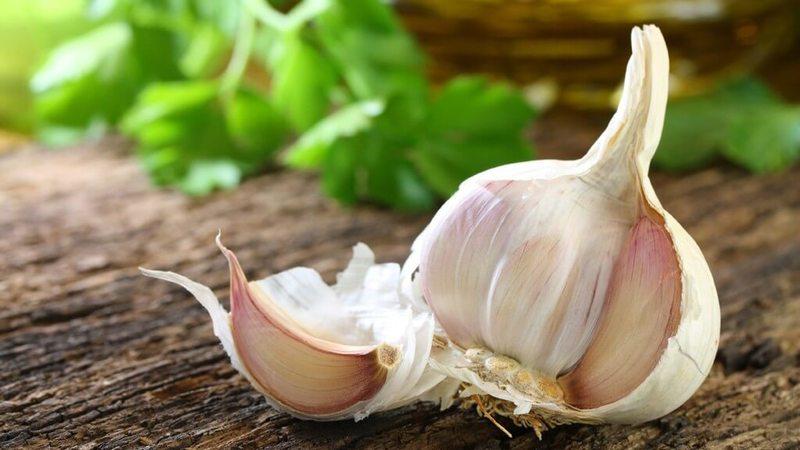
Garlic feeding scheme
Spring is the time of growth of green mass. During this period, the plant needs nitrogen fertilizing.
In summer, they compensate for the lack of nutrients for the formation of the bulb.
In the fall, fertilize the soil before planting:
- under winter garlic for normal wintering and good germination;
- under spring, so as not to dig up half-frozen soil in the spring.
Attention! A third of nitrogen and half of sulfate-potassium fertilizers are applied during pre-planting cultivation.
Number of feedings
During the growing season, garlic is fed 2 times; additional fertilizing is introduced if there are signs of micronutrient deficiency on the plant.
Feeding is planned taking into account the vegetative phases, or stages of growth.
There are two signs that help determine the beginning of the first and second stages:
- The first is the appearance of 3-4 green leaves, indicating the need to apply nitrogen fertilizers. Previously, the plant does not require them, since reserves from the planting clove are used and there are not enough leaves that need nitrogen.
- Second, the appearance of 6-8 green leaves means the beginning of the ripening stage of the bulb. From this moment, fertilizing garlic with nitrogen fertilizers is stopped due to the risk of bulb deformation.
Attention! Garlic does not like waterlogging, so fertilizing is combined with watering.
Which soil should I add which fertilizers to?
Garlic is picky about soil:
- winter varieties love neutral sandy loam;
- spring varieties prefer slightly acidic loam.
Having determined the quality of the soil on the site, it is easy to provide plants with conditions for comfortable growth.
The mechanical composition of the soil determines its density, water and air permeability, and moisture capacity.
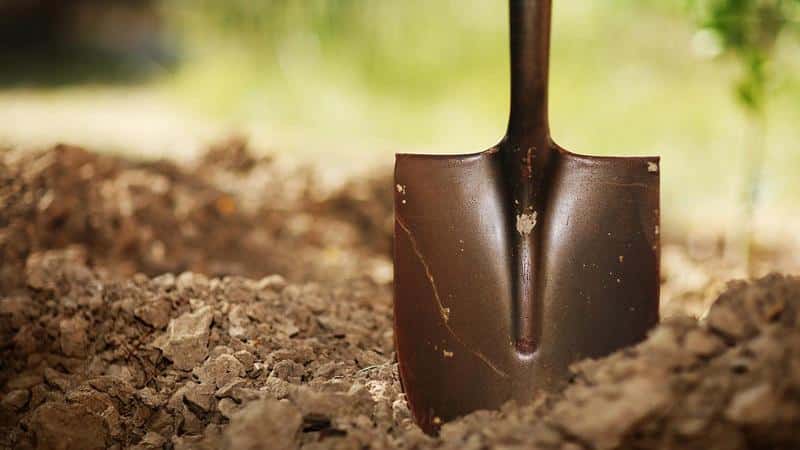
According to the mechanical composition of soils, they are divided into:
- heavy: clayey;
- medium-heavy: loamy;
- light: sandy and sandy loam.
Heavy soils are distinguished by a wealth of mineral elements in a form that is inaccessible to plants, but they quickly become compacted; after rain, the surface becomes crusty. Water often stagnates on them, and plant roots suffer due to waterlogging.
Microorganisms work poorly in them and organic matter slowly decomposes, resulting in nutritional deficiency. In spring, areas with such soil take longer to warm up, melt water leaves later, and planting begins late.
To correct the situation, loosening components are added - for example, sawdust or sand. Effective sowing of green manure: choose crops with a strong root system that penetrates deep into the ground.
Light soils provide complete air exchange and quickly warm up in the spring, but do not retain water, losing nutrients along with it.
Moisture capacity is increased by adding clay or large doses of organic matter.
Attention! Peat should be treated with caution: it increases the acidity of the soil and does not contain nutrients.
To roughly determine the composition of the soil, pour vinegar over a lump of dry soil (alkaline soil will make noise) or rinse the sample with distilled water and then dip litmus paper into it (with an acidic reaction, the paper will turn red, and with an alkaline reaction, it will turn blue).
Under natural conditions, it is possible to draw a conclusion about the acidity of the soil based on some plants. For example, horsetail, pickleweed, mint, buttercup, plantain, etc. usually grow on acidic soils, and coltsfoot, wild or field radish on neutral soils; Indicator plants such as chamomile, white creeping clover, and mustard will tell us about the alkaline reaction of the soil.
Acidity is expressed in terms of pH, a measure (i.e., decimal power) of the reciprocal of the concentration of hydrogen ions (H+), in units from 0 to 14. A pH value of 7.0 is neutral, higher is alkaline, lower is acidic.
Soil acidity is taken into account before planting to protect plants from disease, starvation, weakened development or death.
In acidic soils (pH 4.0-5.5), iron, aluminum and manganese are in forms available to plants, and their concentrations reach toxic levels. At the same time, the supply of phosphorus, potassium, sulfur, calcium, magnesium, and molybdenum to plants is difficult. On acidic soil, increased loss of plants may occur without external causes - soaking, death from frost, development of diseases and pests.
On the contrary, in alkaline (pH 7.5-8.5) iron, manganese, phosphorus, copper, zinc, boron and most trace elements become less available to plants.
Reduce acidity by liming. The need for soil deoxidation occurs less frequently. Dolomite flour, lime and chalk, and wood ash are used.
High acidity can be reduced by adding lime to the soil, and high alkalinity can be reduced by adding acidic fertilizers: superphosphate, sulfates. Different types of soil also have different abilities to maintain a constant chemical reaction. We can say that most soils tend to gradually oxidize.
At the same time, sandy soils, unlike clay soils, have difficulty maintaining constant chemical properties. Lime should be added to them in small portions, but often, while heavy soils will tolerate higher doses.
If the garlic leaves are deformed, change color or their development has stopped, the plant should be fed.
How to prepare compositions for fertilizing
The composition of fertilizers is determined taking into account:
- degree of soil fertility, its mechanical composition and acidity;
- climate, precipitation, probability of frost;
- illumination of the area;
- predecessors of garlic and its neighbors;
- characteristics of the variety, ripening period.
The composition of the mixture can be calculated based on all these conditions in each specific case.
For example, if the soils are acidic and heavy, a spring variety with a long growing season of green mass is planted in a bed in partial shade, when preparing the soil you will need to add potassium sulfate and feed it twice with nitrogen-containing fertilizer with an interval of at least 2 weeks, supplemented with organic matter in the form of a bait component or foliar fertilizer .
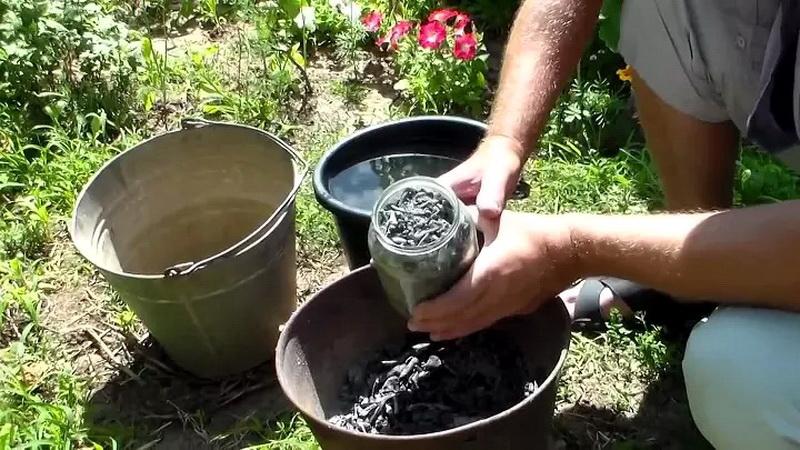
Mineral fertilizers for strengthening garlic planted before winter
Nitrogen starvation helps plants survive frosts. When the first shoots of a winter variety appear, the soil has not yet thawed, the bacteria in the soil have not activated, so nutrients are not available to the root system.
In spring, plants need nitrogen, they consume it in huge doses. However, it is necessary to control the amount of fertilizer and choose the right one for the site.
Urea or Urea – A valuable source of nitrogen, it can be dangerous in alkaline soils, where it quickly decomposes into carbon dioxide and ammonia.
Ammonium nitrate is useful for alkaline and neutral soils; on acidic soils it is combined with calcium carbonate in a proportion of 0.75 g per 1 g of nitrate.
Superphosphate is useful when there is a lack of phosphorus in the soil. A sign of deficiency is a change in the color of the leaves to dark green or even blue, the appearance of a rusty tint.
Potassium sulfate is added to the soil before planting; it helps plants survive the winter and nourishes them in the spring. In heavy clay soils and loams, it does not transfer well into the soil composition and becomes locally locked at the point of application.
Kalimag is suitable for light soils, peaty ones - in combination with liming. When purchasing, pay attention to the origin of the raw materials: depending on the place of extraction of potassium chloride, the radiological background may be increased. An excess of potassium and magnesium weakens the root system.
Nitrophoska: the amount of the main fertilizer elements - nitrogen-phosphorus-potassium - may vary, as indicated on the labeling; for garden plants, 16:16:16 is suitable. An easy-to-use fertilizer that is effective on all types of soil.
Nitroammofoska is rich in all the substances necessary for a plant at different stages of life. It is used for pre-sowing application, top dressing and foliar feeding, saves time and money, but provokes a concentration of nitrates in the soil, is easily flammable and explodes.
Organic fertilizers and folk remedies
A combination of organic nutrition and minerals is beneficial for garlic. Complete soil fertilization in the fall is often enough to provide crops for the entire growing season.
Attention! Garlic does not tolerate fresh manure and unripe humus.
Fresh manure, which enriches light soils, is applied to the preceding garlic crop at the rate of 7–10 kg per square meter. m., chicken droppings - 2 times less.Semi-decomposed manure can be applied in the fall when preparing the site for spring planting of spring varieties.
Raw humus is useful for the first deep cultivation; it oxidizes the soil.
Mulching with mature organic matter does not overload the soil, and spraying and fertilizing with organic infusions gives an immediate effect - however, this can attract pests to the garden bed. Compost is a favorable environment not only for worms, but also for pests such as mole crickets and cockchafers, which leave their offspring in the compost.
Green manure is classified as an organic method of fertilization. However, their effect covers the entire spectrum of reclamation: they replenish the soil with minerals, including nitrogen, promote the decomposition of sparingly soluble phosphorus compounds, reduce the loss of moisture and mobile nutrients in the soil, improve its agrophysical parameters, and reduce weediness.
Some have a phytosanitary effect, suppressing the proliferation of garlic pests. Green manure is planted before garlic or at the same time as it.
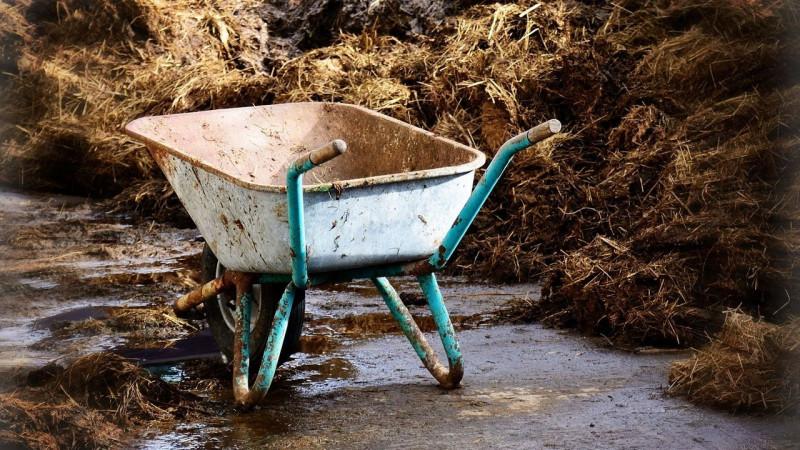
Foliar feeding
Spraying fertilizers on the stems and leaves of garlic increases the intensity of nutrient absorption by the plant, but does not replace soil preparation and basic fertilizing.
Mixtures with lower concentrations are used, they can be both mineral and organic. Spray in the evening or in cloudy weather.
Attention! The method is used when there are signs of a lack of necessary substances.
Folk remedies for feeding garlic
The list of fertilizers for garlic is not limited to traditional agrochemicals - thanks to the ingenuity of domestic gardeners, a number of other effective fertilizers are used.
Chicken droppings
Such droppings contain nitrogen, potassium, phosphorus and magnesium, increase resistance to bacterial and fungal infections, prevent the appearance of mold on the soil surface and help plants survive drought. Accelerates compost maturation.
It is recommended to add 3-3.5 kg per square meter to the soil intended for planting garlic before planting the previous crop. m.
For feeding, dissolve 1-1.5 kg in 15-20 liters of water, consumption - 3-4 liters per 1 sq. m. Water between the rows of garlic. The solution should not come into contact with leaves and roots.
Attention! It is unsafe to work with fresh droppings without gloves and a mask due to the large number of helminth eggs and the high content of pathogenic microorganisms for humans.
Hydrogen peroxide
The atomic oxygen contained in hydrogen peroxide will help garlic produce gas on heavy soils. The bactericidal properties of peroxide will protect against the appearance of rot and fungal diseases.
Instead of ordinary water, water with a solution in a proportion of 1.5-2 tbsp. l. for 1 liter of water.

Wood ash
The chemical compounds of calcium, potassium, sodium and magnesium contained in the ash nourish plants and help defeat diseases.
When the edges of the leaves begin to turn yellow and dry out, the ash is scattered under the plants before watering.
Attention! Contraindicated on alkaline soils.
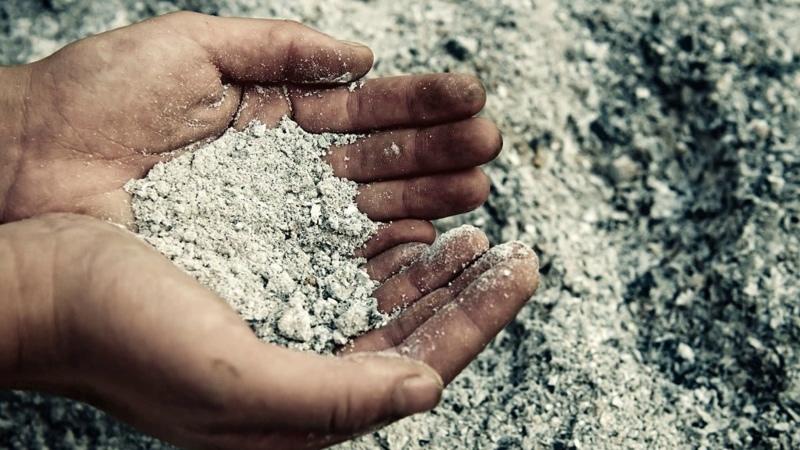
Yeast
They activate the activity of microorganisms in the soil, promoting a change in composition and activating the production of nitrogen and potassium. Increases plant endurance in low light conditions.
Fertilizing with yeast will not replace a full complex of fertilizers, but will become an additional growth stimulator. There are many recipes for yeast fertilizers; they are used depending on the composition of the soil.
Ammonia
Aqueous ammonia with a high nitrogen content.In combination with organic components, it avoids soil acidification. Spraying with a mixture of soap solution and ammonia protects against pests.
Attention! Ammonia poisoning occurs through the skin, mucous membranes and respiratory tract. When using ammonia, be sure to use rubber gloves, a respirator, goggles and an apron made of non-woven materials.
Why consider garlic precursors?
Garlic is sensitive to predecessors and neighbors.
So that an unfavorable neighborhood does not inhibit the growth process of the plant and does not lead to the degeneration of the seed, follow a few recommendations:
- It’s good to plant garlic after legumes, cabbage, melons, cucumbers, lettuce and green manure;
- bad - after onions, potatoes, tomato;
- gets along next to the salad, beans, tomatoes, parsnips and kohlrabi;
- does not like being next to radishes, beets, carrots, asparagus and spinach.
Conclusion
The decision on how to fertilize garlic is made depending on capabilities, productivity requirements and personal preferences. An indicator of the fruitfulness of efforts is the plant itself, not only after harvesting, but also during the growth process. Constant cultivation of the soil, control of the amount of fertilizers and bait of all types used will not slow down the impact on a high-quality and tasty harvest.